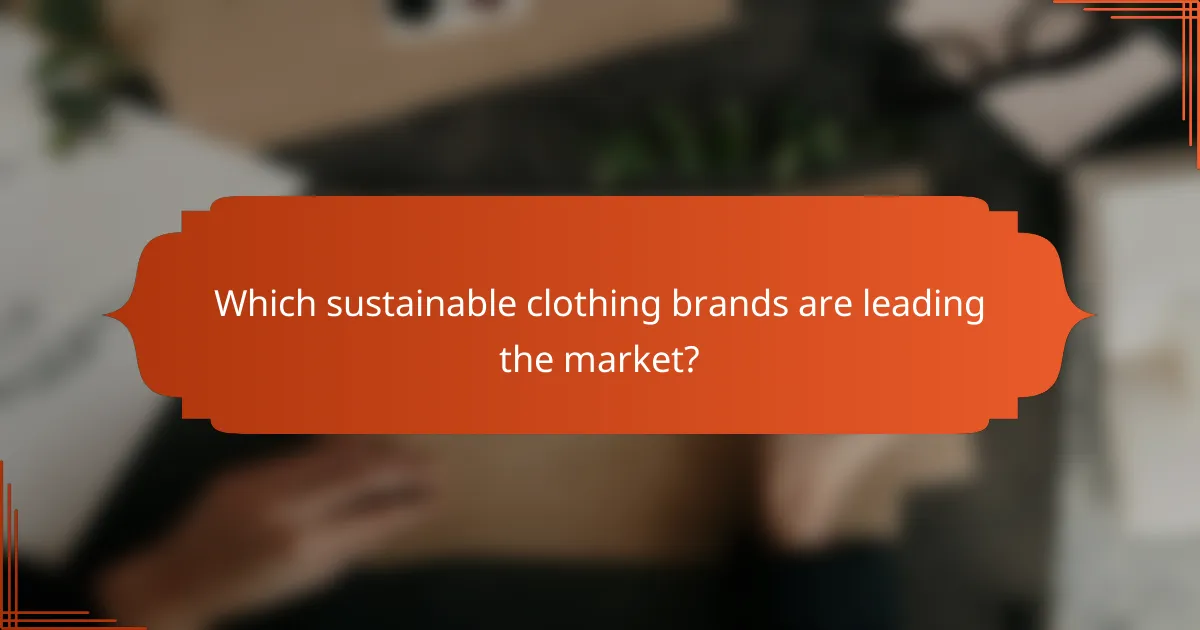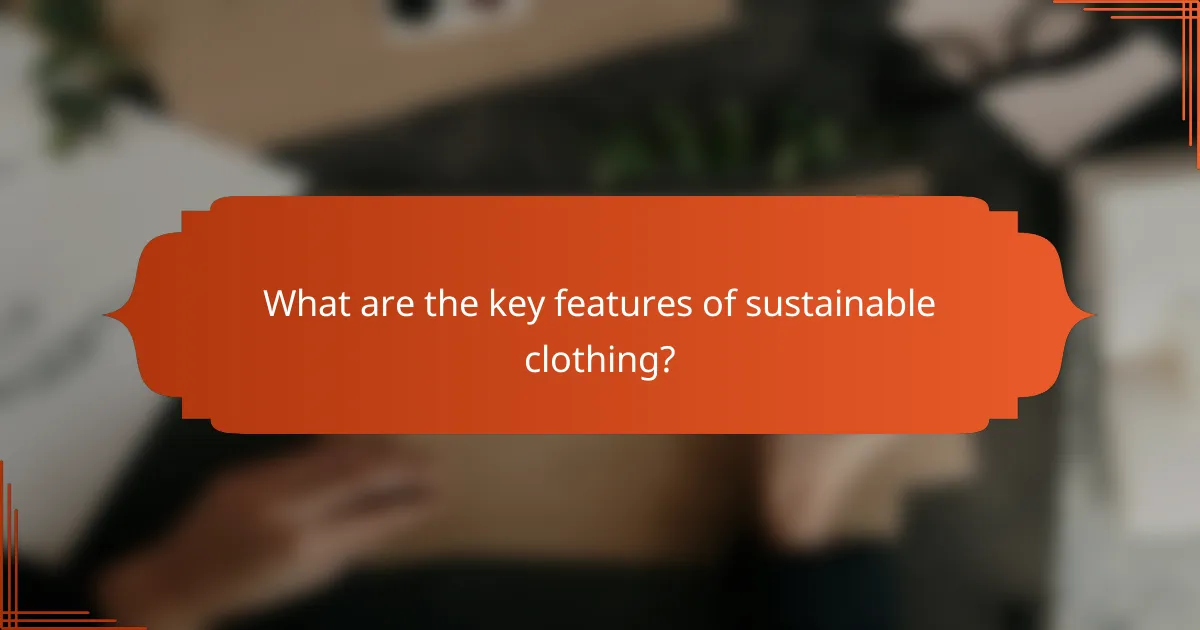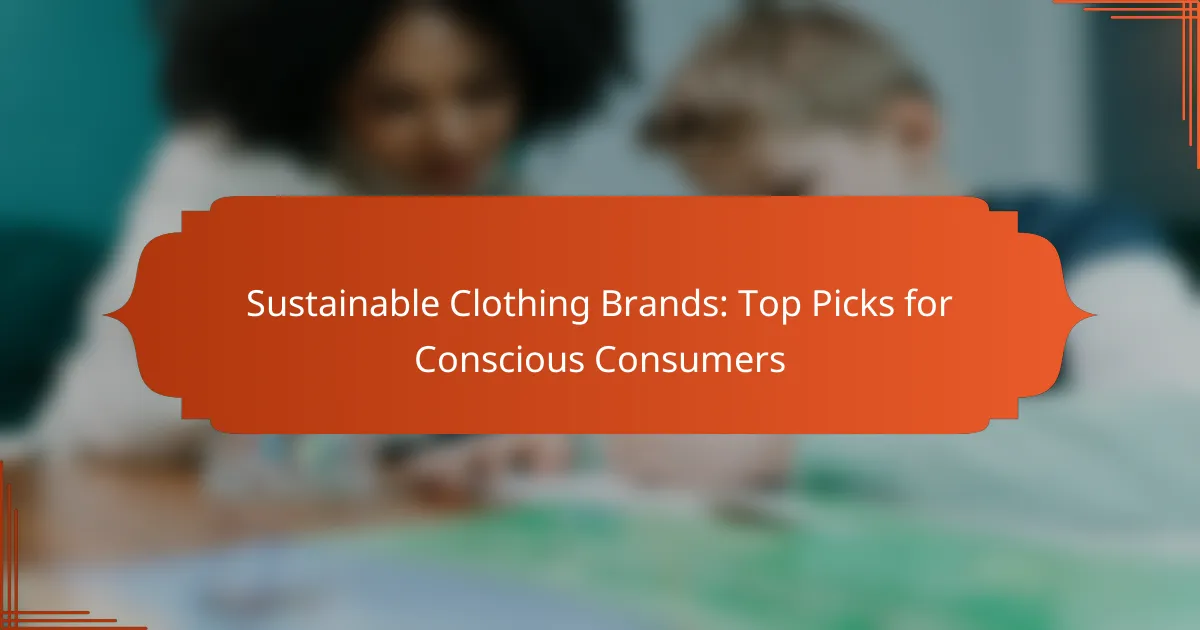As the demand for eco-friendly fashion grows, several sustainable clothing brands are leading the way with their commitment to ethical production and environmentally responsible materials. These brands not only offer stylish options for conscious consumers but also emphasize transparency and fair labor practices, making it easier to make informed choices that align with personal values.

Which sustainable clothing brands are leading the market?
Several sustainable clothing brands are at the forefront of the market, focusing on eco-friendly materials, ethical production practices, and transparency. These brands not only prioritize environmental responsibility but also cater to conscious consumers seeking stylish and sustainable options.
Patagonia
Patagonia is renowned for its commitment to environmental activism and sustainable practices. The brand uses organic cotton, recycled materials, and offers a repair program to extend the life of its products. Their dedication to transparency includes detailed information about their supply chain and environmental impact.
When choosing Patagonia, consider their wide range of outdoor apparel, which is designed for durability and performance. Look for their Fair Trade Certified options, which ensure fair labor practices in production.
Eileen Fisher
Eileen Fisher focuses on timeless designs and sustainable materials, including organic and recycled fibers. The brand emphasizes ethical manufacturing processes and has a take-back program to recycle old garments, promoting a circular economy.
For consumers, Eileen Fisher offers a selection of versatile pieces that can be mixed and matched. Their commitment to size inclusivity and fair wages makes them a strong choice for conscious shoppers.
Reformation
Reformation is a trendy brand that combines style with sustainability, using eco-friendly materials and practices. They track their environmental impact and provide transparency through their “RefScale,” which shows the sustainability of each item.
When shopping at Reformation, look for their collections that feature limited-edition styles, which often sell out quickly. Their commitment to reducing waste and carbon emissions makes them a popular choice among younger consumers.
Everlane
Everlane is known for its “Radical Transparency” policy, revealing the true costs behind each product. The brand uses sustainable materials and ethical factories, ensuring fair wages and safe working conditions for workers.
Consumers can benefit from Everlane’s focus on essentials, offering high-quality basics that are designed to last. Their pricing is competitive, making sustainable fashion accessible without sacrificing style.
People Tree
People Tree is a pioneer in sustainable and fair trade fashion, focusing on organic materials and ethical production. The brand collaborates with artisans and farmers to create unique, handcrafted pieces that support local communities.
When considering People Tree, look for their certifications, such as GOTS (Global Organic Textile Standard), which ensures high environmental and social standards. Their collections often feature bold prints and styles that stand out while promoting sustainability.

What are the key features of sustainable clothing?
Sustainable clothing is characterized by eco-friendly materials, ethical labor practices, and durability. These features ensure that garments are produced with minimal environmental impact and promote fair treatment of workers.
Eco-friendly materials
Eco-friendly materials are those sourced from renewable resources or recycled content, reducing the demand for virgin materials. Common examples include organic cotton, Tencel, and recycled polyester. When shopping, look for certifications like Global Organic Textile Standard (GOTS) or OEKO-TEX, which indicate environmentally responsible production processes.
Choosing clothing made from these materials can significantly lower your carbon footprint. Additionally, consider the lifecycle of the fabric; biodegradable options can minimize landfill waste when the garment is discarded.
Ethical labor practices
Ethical labor practices ensure that workers involved in the clothing production process are treated fairly and compensated adequately. Brands that prioritize these practices often provide safe working conditions, reasonable hours, and a living wage. Look for brands that are transparent about their supply chains and have certifications such as Fair Trade.
Supporting companies that adhere to ethical labor standards not only benefits workers but also aligns with the values of conscious consumers. Avoid brands that lack transparency or have been linked to labor exploitation.
Durability and longevity
Durability and longevity are essential features of sustainable clothing, as they reduce the frequency of replacement and waste. High-quality garments made from robust materials can withstand wear and tear, extending their lifespan. When evaluating durability, consider the stitching, fabric weight, and overall construction of the item.
Investing in timeless, well-made pieces can save money in the long run and lessen environmental impact. Avoid fast fashion items that may be cheaper upfront but often wear out quickly, leading to more waste and consumption.

How to choose sustainable clothing brands?
Choosing sustainable clothing brands involves assessing their environmental impact, ethical practices, and commitment to transparency. Focus on certifications, sourcing practices, and production locations to ensure your choices align with your values.
Research brand certifications
Brand certifications are essential indicators of a company’s commitment to sustainability. Look for certifications like Global Organic Textile Standard (GOTS), Fair Trade, and OEKO-TEX, which signify adherence to environmental and social standards.
These certifications often require brands to meet specific criteria regarding materials, labor practices, and environmental impact. Checking for these labels can help you identify brands that prioritize sustainability.
Evaluate transparency in sourcing
Transparency in sourcing is crucial for understanding a brand’s supply chain and ethical practices. Brands that openly share information about where and how their materials are sourced demonstrate accountability and a commitment to sustainability.
Look for brands that provide detailed information on their websites about their sourcing practices, including the origin of materials and the conditions under which they are produced. This can help you make informed decisions about your purchases.
Consider local production
Supporting brands that produce locally can significantly reduce carbon footprints associated with transportation. Local production often means shorter supply chains and better oversight of labor practices.
When evaluating brands, consider those that manufacture within your country or region. This not only supports local economies but also often ensures higher standards of labor and environmental practices.

What are the benefits of buying sustainable clothing?
Buying sustainable clothing offers numerous advantages, including a reduced environmental footprint and support for ethical labor practices. These benefits not only contribute to a healthier planet but also promote fair treatment of workers in the fashion industry.
Reduced environmental impact
Sustainable clothing is designed to minimize harm to the environment. This includes using organic materials, reducing water consumption, and employing eco-friendly production methods. By choosing these options, consumers can help decrease pollution and waste associated with traditional fashion manufacturing.
For instance, brands that utilize recycled fabrics can significantly lower the amount of new resources needed, leading to less deforestation and energy use. Additionally, many sustainable brands focus on local production to reduce transportation emissions.
Support for ethical labor
Purchasing sustainable clothing often means supporting brands that prioritize fair labor practices. These companies typically ensure that workers are paid fairly and work in safe conditions, adhering to ethical standards. This contrasts sharply with fast fashion, where labor exploitation is common.
Look for certifications such as Fair Trade or GOTS (Global Organic Textile Standard) when selecting brands. These labels indicate a commitment to ethical labor practices and can guide consumers in making responsible choices.
Long-term cost savings
Investing in sustainable clothing can lead to long-term savings. While the initial purchase price may be higher, sustainable garments are often made to last longer than fast fashion items. This durability means fewer replacements over time, ultimately saving money.
Consider the cost-per-wear approach: a high-quality sustainable shirt worn hundreds of times may cost less in the long run than multiple cheaper shirts that wear out quickly. Additionally, many sustainable brands offer repair services, further extending the life of your clothing.

Where to find sustainable clothing in major cities?
Major cities often have a variety of options for finding sustainable clothing, including dedicated eco-friendly boutiques, thrift shops, and larger retailers with sustainable lines. Exploring local markets and online platforms can also yield unique finds that align with conscious consumer values.
Eco-friendly boutiques
Eco-friendly boutiques are a great starting point for sustainable clothing. These shops typically curate collections from brands that prioritize ethical production, organic materials, and fair labor practices. Look for boutiques that provide transparency about their sourcing and manufacturing processes.
In cities like New York, Los Angeles, and London, you can find numerous eco-conscious boutiques. For example, stores such as Reformation and Eileen Fisher offer stylish options while maintaining a commitment to sustainability.
Thrift and vintage shops
Thrift and vintage shops are excellent places to discover sustainable clothing at lower prices. By purchasing second-hand items, you contribute to reducing waste and extending the lifecycle of garments. Many thrift stores also support local charities, adding a community benefit to your purchase.
In cities, you can often find well-stocked thrift shops in neighborhoods known for their eclectic style. Popular chains like Goodwill and Salvation Army, as well as local vintage shops, can provide a wide range of clothing options.
Online sustainable retailers
Online sustainable retailers have gained popularity, offering a convenient way to shop for eco-friendly clothing. Websites like Everlane, Patagonia, and ASOS’s Eco Edit feature a range of sustainable options, from casual wear to activewear. Many of these retailers provide detailed information about their sustainability practices.
When shopping online, look for certifications such as GOTS (Global Organic Textile Standard) or Fair Trade, which can help ensure that the clothing meets specific environmental and ethical standards.
Local markets and pop-up shops
Local markets and pop-up shops often showcase independent designers and sustainable brands. These venues provide an opportunity to support local artisans while finding unique clothing items. Many markets focus on sustainability, featuring vendors who prioritize eco-friendly practices.
Check community boards or social media for upcoming markets in your area. Participating in these events can also connect you with like-minded individuals and provide insights into sustainable fashion trends.
